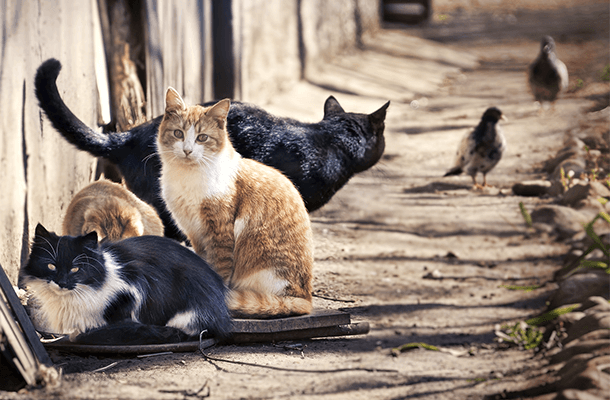Scientists Call for New Cat Management Strategy to Reduce Risk of Toxoplasmosis
Media Contact: Jordan Rutter, Director of Public Relations, 202-888-7472 | jerutter@abcbirds.org
Expert Contact: Grant Sizemore, Director of Invasive Species, 202-888-7480 | gsizemore@abcbirds.org

Cats are the definitive host for the parasite Toxoplasma gondii, which poses a serious health concern for people and wildlife. Photo by LedyX/Shutterstock
(Washington, D.C., May 1, 2019) New research published in EcoHealth by veterinary, public health, and wildlife conservation scientists, including American Bird Conservancy's (ABC's) Director of Invasive Species Programs Grant Sizemore, calls for an updated approach to managing human and animal exposure risks to the parasite Toxoplasma gondii, which causes the disease toxoplasmosis. Over 1 million people in the United States are infected with T. gondii each year, and research focused on wildlife populations increasingly indicates widespread environmental contamination and endangered species deaths.
To reduce environmental exposure risks for people, wildlife, and domestic animals, the study's authors identified the importance of policies that reduce the number of domestic cats (Felis catus) outdoors. Domestic cats and other felines are the definitive hosts for T. gondii and are the only species to excrete the parasite's infectious eggs (oocysts) into the environment. According to the authors, “Recent studies have demonstrated that environmental oocyst transmission is the major route of T. gondii transmission, presenting a direct public and animal health problem.”
“The best way to manage infectious disease risks from cats — whether it be toxoplasmosis, rabies, or any other disease — is to keep cats safely contained indoors, on a leash, or in a catio,” said ABC's Sizemore. “Permitting cats, especially stray and feral cats, to roam the landscape increases risks to the whole community, human and animal alike.”
T. gondii infection has long been recognized as a risk for pregnant women, but new research has emphasized chronic and acute infection risks in all people. Consequences of infection may include miscarriage, premature birth, deafness, cognitive decline, and even death. Toxoplasmosis is also a major cause of blindness, with an estimated 5,000 people developing ocular toxoplasmosis in the United States every year.
“Serological evidence of exposure to T. gondii has also been associated with an increased risk of neuropsychiatric diseases, such as schizophrenia, and suicide attempts,” said Dr. Robert Yolken, Ted and Vada Stanley Distinguished Professor of Pediatrics at Johns Hopkins School of Medicine and study co-author. “The mechanisms of this association are under study and may include altered levels of brain inflammation and neural transmission.”
T. gondii infection in domestic animals is similarly concerning. Livestock such as sheep, goats, and pigs are particularly susceptible, and all infected livestock destined for human consumption may present a public health concern if people consume contaminated meat. Despite this fact, the United States Department of Agriculture recently terminated its research program on T. gondii, even though toxoplasmosis is the second leading cause of death among foodborne illnesses in the United States, after Salmonella.
Studies on wildlife infections with T. gondii suggest widespread environmental contamination affecting terrestrial, freshwater, and marine wildlife, such as White-tailed Deer and Southern Sea Otters. All birds and mammals are susceptible to infection, and all felines serve as a definitive host for the parasite. According to the study, however, “Domestic cats are likely the major source of ecosystem contamination in many areas due to their high abundance on the landscape relative to native felids.”
Nowhere is the impact of domestic cats on wildlife more apparent than in Hawaiʻi, where no other felines are present. Infections in Hawaiian wildlife such as the Hawaiian Monk Seal, Nēnē (Hawaiian Goose), and ʻAlalā (Hawaiian Crow), can be fatal and represent a significant conservation risk to these endangered species.
“If we are going to have any hope of reducing exposure risks to people and animals, we have to reduce the number of domestic cats roaming outdoors,” said Sizemore. “American Bird Conservancy urges public policies that safely contain domestic cats, which simultaneously limit the spread of infectious diseases, protect wildlife, and support longer, healthier lives for cats.”
###
American Bird Conservancy is a nonprofit organization dedicated to conserving birds and their habitats throughout the Americas. With an emphasis on achieving results and working in partnership, we take on the greatest problems facing birds today, innovating and building on rapid advancements in science to halt extinctions, protect habitats, eliminate threats, and build capacity for bird conservation. Find us on abcbirds.org, Facebook, Instagram, and Twitter (@ABCbirds).



















































